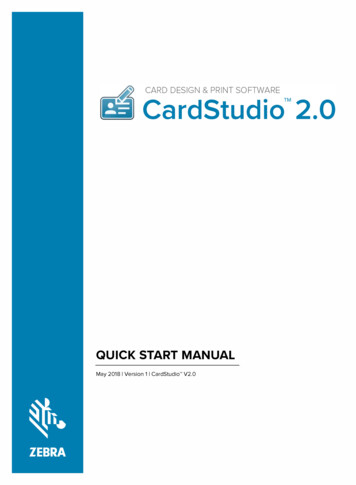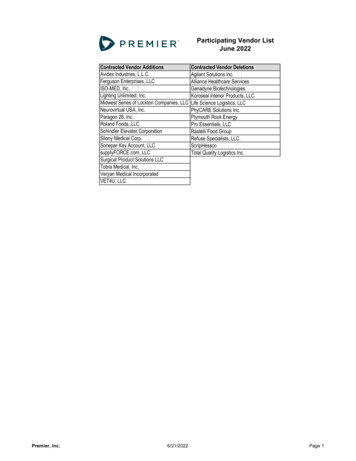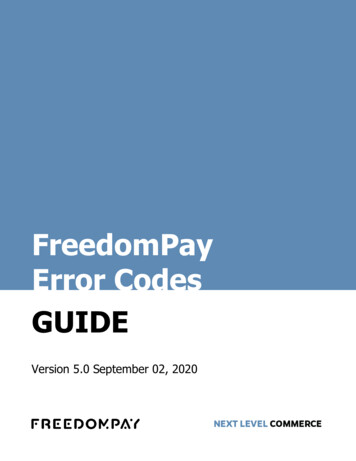
Transcription
Private Practice Startup Guide for Mental Health Cliniciansby L. Gordon Brewer, Jr., MEd, LMFT 2019 Kingsport Counseling Associates, PLLCAll rights reserved. No portion of this book may be reproduced in any formwithout permission from the publisher, except as permitted by U.S. copyright law.For permissions contact:L. Gordon Brewer, Jr.The Practice of Therapy605 Watauga StreetKingsport, TN rapy.comAcknowledgments:For my wife “Sister” who is brave and continues to win against cancer.For my daughter Rebecca who makes me laugh and brings me unending joy.For my community of friends both in my private life and in business who have supported me all along theway!My colleagues at Kingsport Counseling Associates, PLLC who have encouraged and taught me much!Legal Stuff:This publication is written to provide accurate and authoritative information in regard to the subjectmatter covered. It is provided with the understanding that the author and publisher are not engaged inrendering legal, accounting or other professional services. If legal advice or other expert assistance isneeded, the services of a competent professional person should be sought.Please do not copy this book illegally!WWW.PRACTICEOFTHERAPY.COM-1-
ContentsIntroduction . 3Step 1- Finding a Place to Meet with Clients .Other Business Models In-Home Counseling Online Therapy 5666Step 2 - Getting Clients and Referrals Identify Your Niche .Naming Your Practice .Developing An Internet Presence .Creating Content .Blogging Podcasts Social Media Directories .Referral Sources Email Marketing .Workshops and Seminars Insurance Panels .Marketing .789910101111121213131414Step 3- Setting Up The Office and Running the Practice .“Clinical Department” .Practice Management Systems (EHR) .Word Processors and Spreadsheets .Paper Documents .“Business Department” .Communicating With Clients .Phone Systems G-Suite and Emails .“Knowing Your Numbers” .Tracking Your Numbers Paperwork and Forms Taking Credit Cards 15151616171718181920202223Step 4 - Get Started Now! . 2410 Things To Do Now . 24Conclusion .25WWW.PRACTICEOFTHERAPY.COM-2-
So where are you in your journey? Maybe you are you a graduate student or recent grad who islooking toward going into private practice. You have gotten some great clinical training and areready and willing to see clients. The problem though is that you really did not get the businesstraining you needed to know how to run a private practice.Or maybe you are already working full-time for an agency and feeling like you are always burningthe candle at both ends. The caseloads seem to constantly stay over-loaded. There seems tobe an endless stream of paperwork and deadlines. You stay “on eggshells” from being on-calland not knowing when the next crisis with a client will hit. Court dates, follow-up with psychiatristsand doctors, intakes, discharge summaries, treatment plans, utilization reviews, treatment teammeetings, safety plans.the list goes on and on For financial reasons, you are afraid to leavethat job or only make a lateral move to another agency to just get more of the same.Do any of these describe where you are in your journey as a clinician? Are you graduate studentready to start into private practice but not sure when or how? Are you feeling burned-out andstuck working for an agency?My own story and journey into private practice started about 15 years ago. I was working for anagency feeling all the pressure and feeling stuck in my career. I was working 60 hours a weekand felt like I was getting nowhere. I was not getting to spend the time that I wanted with myfamily. My weekends were spent getting caught up on paperwork. I felt like I really was burningthe candle at both ends.It wasn’t that I did not want to be a therapist, it just felt like I was not thriving or doing what I reallywanted to do in my career. Because of this, I began the process of building a part-time privatepractice. Once I started that private practice, it gave me sense of hope and motivation. Theagency work somehow felt less burdensome because I knew I was not going to be doing thatforever. The agency work was simply a stepping stone to bigger and better things for my career.That part-time counseling practice I started began to grow. It grew to the point that I was able toleave the security of my agency job and devote all of my time to my own private practice. Now Ihave a thriving group practice with 4 other counselors/therapist working with me.You can do that too!Going into private practice is absolutely doable. There are no real “get rich quick” schemes withprivate practice. But by starting small and being patient with the process of building a privatepractice, it can grow into something that is supporting and sustainable.WWW.PRACTICEOFTHERAPY.COM-3-
To be totally realistic, very few private practices are financially sustainable and viable when theyare getting started. That takes some time to build. But by putting the right systems in place andfocusing on building the business (yes, it is a business!), you can create something that issustainable and supports the lifestyle you want to live.In general, it takes most practices about 2 years to reach this point. And if the right things aredone in terms of marketing the practice and having the right systems in place, you can reachviability with your practice much sooner. The formula is pretty simple. You have to bring in moremoney than you spend. You have to pay yourself, pay taxes, have the business expenses coveredand make a profit.The key to success is to be patient with small incremental growth. Then before you know it, youwill reach a point of momentum that can take you to success and having your ideal practiceserving your ideal clients. You can find meaning and purpose in your work and absolutely live thelifestyle you want for yourself.What to expect from this guideThis guide does not contain “everything” you need to know about running a private practice.Nonetheless it will hopefully get you headed in the right direction. The next few pages will guideyou through some steps you can take now to begin your private practice by starting small andgrowing. It will give you some basic things you will need to think about and know as you moveinto private practice and start the process of being your own boss.Links to ResourcesThroughout this guide there are links to resources that I recommend. And to be fullytransparent about this, some of these links are affiliate links which means that I do receivea commission, with no extra cost to you, if you use the link to the purchase products orservices suggested. I only recommend those products and services that I use myself orknow come highly recommended. Thanks in advance for using the links!Let’s start the journey!WWW.PRACTICEOFTHERAPY.COM-4-
Step 1- Finding a Place to Meet with ClientsWhere and when you see potential clients as you begin a private practice can range from easy tocomplicated. Either way, it is important for you to begin thinking outside the box. The two obviousthings you need to consider are location and cost. The other thing to consider is the businessmodel you might want to use for your practice. It makes sense that before you go to the expenseof paying full monthly rent for your own space, that you look into sharing office space withsomeone or other less traditional models for providing services (ex., online therapy or in-homecounseling)Finding the placeHere is where thinking outside the box is important. So here are some ideas to consider as youthink about finding a place to start seeing clients: Who do you know that might have some unused office space? Doctors, attorneys andbanks typically do not use their office space in the evenings and on weekends. Churches and other houses of worship typically have lots of unused space throughout theweek. In fact, depending on where you are, they are usually happy to have their spaceused during the week and it also gives them some “outreach” in the community. Other counselors and therapists that are in private practice might have times they are notseeing clients and would be willing to share the cost of their office. Check local listings like Craigslist to see what sort of office space might be out there. Ifyou do not have access or know any of the above, post an ad on Craig’s List, “office spaceneeded” to see what leads you might get.WWW.PRACTICEOFTHERAPY.COM-5-
Other Business ModelsIn-Home CounselingAnother concept to consider is doing in-home counseling. You may or may not have a comfortlevel with doing it this way, but there are a lot of counselors that have built very successfulpractices around going to the client rather than the client coming to you. Of course you need toknow something about your clients and where they live. Be safe about this one.Online TherapyOnline Counseling, often referred to as “Tele-Therapy”, is an up and coming way to deliverpsychotherapy services. With this type of service you simply meet with clients online by videoconferences. There are therapists that have built whole practices around providing this type ofcounseling and even do it exclusively to traditional face to face counseling.There are more and more platforms that are emerging that are secure and designed specificallyfor counselors and therapists doing online counseling. Services like Talkspace and 7 Cups ofTea are designed to provide the platform and marketing for therapists doing online therapy. Thesemight provide a good place to start in that they are somewhat turn-key. Essentially a therapistsigns up to be a provider for one of these services. They do have a credentialing process thatyou will need to through in which you verify your license and liability insurance coverage.Another option is to be more do-it-yourself and use a platform that is specific to your practice. Ican recommend Doxy.me as a good basic and secure platform to start with. Doxy.me is a freeservice for single users. Another one that is good is Zoom.com . It is a paid service but a goodreturn on investment if you go with them. Both these platforms are HIPAA secure and you canget the BAA required by HIPAA.Do spend some time learning about the legal and ethical issues around tele-therapy. Some greatresources for this are with Clay Cockrell’s Online Counselling Directory Toolbox and RobReinhardt’s Tame Your Practice. Also, check out Roy Huggins Person Centered Tech for allthings about HIPAA and Technology in the mental health field.WWW.PRACTICEOFTHERAPY.COM-6-
Step 2 - Getting Clients and ReferralsOne of the MOST important parts of building a private practice is learning how to market yourpractice. (Yes, I said the “M” word ). This is the fuel that will drive your practice and keep yourschedule full. After all, if you don’t have clients to see you won’t be in private practice very long.And what this will require is learning about the “M” word.MARKETING.Marketing is the one area of having a private practice that tends to intimidate people the most.We do not like to be “salesy”. After all, if you had wanted to be a salesperson, you would havegone into a sales field rather than the mental health field, right?! So I think it is helpful to bethinking about marketing in terms of developing relationships. After all, the number one reasonpeople will refer to you is because they know you.A better way to think about marketing is to think about it in terms of helping people find you. Thereare so many people that need and want your services. They truly need your help. Marketing isthe way you get your message out and help them find you.First of all be patient with the process! Developing a “marketing plan” is simply about developingrelationships and letting potential clients know how you can help them with their problems. If youfocus on this from the beginning, it will be by far the place you will get the biggest bang for yourbuck.So here are the essential components of a good marketing plan. First of all you have to constantlyget new clients. Secondly, you need to be able to retain clients that you get. So here are someof the essential elements I have identified for having a solid marketing plan:1.2.3.4.Know and define your niche.Have a great name for the practice.Have a BOOMING web presence.Have lots of people in the community referring to you directly.WWW.PRACTICEOFTHERAPY.COM-7-
5. Have a high level of value and client satisfaction so that clients refer to you.One book and resource I can highly recommend is Building A Story Brand byDonald Miller. It totally changed the way I think about marketing. He also hasa podcast by the same name.Identify your nicheOne thing that most seasoned therapists in private practice will tell you is to identify a niche tofocus your efforts on. In other words, if you were to identify your ideal client, who would they beand what would their struggles be? What sorts of problems could you best help them with? Whatclinical issues are you drawn to working with? Once you identify this person, this “Avatar” this willbe who you need to market to.So as you start the process of marketing and getting a good referral base for yourself, keep yourideal client in the forefront of your mind. Your “avatar” will be who all of your content, advertisingand wording will be written for.The other thing about having a niche is that it will allow you to do the kind of work that energizesyou. Imagine filling your days with the people you enjoy working with the most. It will not onlyenergize you, but it will make you a better clinician.TIP: Always write and market from standpoint of how you solve client’sproblems, NOT how great you are as a therapist.WWW.PRACTICEOFTHERAPY.COM-8-
What’s in a name?What will be the name of your practice? Let’s think about this for a minute and think like amarketer. The number one referral source for most clinicians usually is their website. So with thatbeing said, your practice name needs to search engine friendly. Start thinking URL.Take some time to Google counselors and therapists in your area. Go to Google and type in“ your city name counseling”. Do the same for “ your city name therapists”. At the bottom ofthe search page that comes up Google will also suggest similar searches. Take a look of someof those. If you were looking for a counselor or therapist and went to Google, what would you typein? Talk to friends and family about this and see what they might Google if they were doing it.Begin by jotting down what you find on the first two pages of Google when you do those searches.Getting any ideas? If you were to name your practice, what would stand out and get yourattention? What would seem inviting?Take some time in brainstorming practice name ideas. You might have had one in mind all alongwhich is great! Do some searching around that name and see what you can find out and if otherideas come to mindDeveloping a web presenceNow that you have thought about a name, take the time to begin thinking about your website.Having a website is absolutely a MUST for going into private practice. It really is your greatestand most valuable marketing tool.A good recommendation is Bluehost for getting your domain name and setting up your initialhosting. It continues to be one of the most reliable and recommended hosting services for thosejust getting started. I also recommend that you use Wordpress for your content managementsystem. Don’t worry too much at this point about building the website or how to set everything up.For now, just focus on the name you will use for the website.WWW.PRACTICEOFTHERAPY.COM-9-
Tip: If you would like to learn more about building your own website, takea look at Daniel Fava’s Create My Therapy Website Toolbox which is acourse that will take you through all the steps. If you are more inclined tohave someone else do the work for you and have more of a “turn-key”way of doing it, Brighter Visions (use this link and get one month free)does a great job and specializes in websites for counselors andtherapists.As has already been suggested find out what practice names are already out there. Use thisinformation to think about a practice and website name. As mentioned already, your websitename/URL should ideally match your practice name. I would also HIGHLY suggest that thewebsite name include the word “counseling” or “therapy” in it because that is what most peoplewould be searching. To just use your name, (ex. “bobsmith.com”) does not convey what you do.But the name, “bobsmithcounseling.com” would be a better choice. Also making the name shorterhelps people remember it and easier to type.Create Content!Once you have your website established, it will be important for you to start blogging and createother forms of content. What this will do is help you establish yourself as an expert in yourcommunity. It will also help increase your SEO (search engine optimization) of your website.There is so much about SEO and content creation that will be important for you to know, that wecannot really cover in this short guide. SEO is what you need to make your website discoverableby potential clients when they do a search. And this does take some time and persistence to getyour ranking in Google to a place where people can find you on the internet.BloggingBlogging is not as difficult as it might seem. There is tons of information on blogging and how todo it well out there on the internet. Whether you like to write or not, blogging is one of the majorelements to helping your website get noticed. You can absolutely learn how to do it and do itwell!WWW.PRACTICEOFTHERAPY.COM- 10 -
PodcastsWhether you know it or not, one of the fastest growing segments of content consumption arepodcasts. Recent statistics indicate that 51% of Americans have listened to podcasts. 22% ofthose listening to podcasts listen to them regularly. And with the current trends, those numberscontinue to go up each year.The advantage of podcasting is that it has a way of creating more intimate and personalconnection for people to you. Hearing the spoken voice draws us in more. It’s a way of gettingthe word out about you and your services in a way that connects in a much different way thanwriting.There is a bit more to the technical side for podcasting. Having a good microphone, knowing howto edit audio, which hosting to use and tools to use are some things you will need to know. Andmuch of the editing side of things can be outsourced. But once you learn these things and getthe tech side of things set up, podcasting can be done easily.Whether to you choose to blog or start a podcast or both, the key is to do them consistently. Theamount is up to you, but I would say to blog at least twice a month, podcast at least once a month.(Weekly is even better )Social MediaAnother part of having a booming internet presence is through Social Media. Of course there area lot of options when it comes to social media. Facebook, Twitter, LinkedIn, Pinterest, Instagram,Snapchat the list goes on and on! The key though is to stick to the ones you like and know thebest.Facebook is of course the most widely used of Social Media sites. I would recommend that yousetup a Facebook Business Page for your practice. It’s free and will give you a way to beginengaging with potential clients and those that might refer to you.Depending on your the demographics of your ideal clients (your “Avatar”), some Social Mediaplatforms will be more suitable than others. For example, if your ideal client is 20-40 somethingfemales, Instagram and Pinterest are probably where you would want to focus your efforts. For20-40 something males, Twitter might be a better place to focus (although this demographic isquickly changing). LinkedIn is good to help establish a professional presence with otherprofessionals that could be potential referral sources.WWW.PRACTICEOFTHERAPY.COM- 11 -
The things to remember about Social Media is the whole “social” aspect. It is something that youwill need to stay on top of and keep adding valuable content that is absolutely relevant to yourpotential clients and referral sources. Social Media is also a tool that you can use to drive trafficto your website. By engaging people there, they will want to know more about what you do andhow you can help them.Tip: Don’t try and do “all” the social medias. Pick one that you enjoy andknow that you will interact with regularly.There are lots of resources out there about how to optimize social media for businesses. Educateyourself on all of that! Again, more resources can be found on http://practiceof therapy.comDirectoriesOne way to get some good referral traffic is to sign up for and invest in some directories. Thebest known, and by far a great return on investment, is the Psychology Today directory. It costsabout 30 a month. And as mentioned, you can get good ROI (return on investment). It if bringsyou just one new client a month, it will absolutely pay for itself!Another one I can recommend and is an up and coming directory is Therapy Den. It is free and aprogressive directory with expansive search filters, as diverse and unique as the society we serve.There are also others to consider. Some of them are even free! Here is a blog post on this.Who do you know that would refer to you?One of the most reliable and best sources of referrals for always come from the personalconnections you make in the community. Doctors, other therapists, clergy, psychiatrists,chiropractors, dentists, massage therapists and any of the other helping professionals can begreat referral sources. Also depending on your client “avatar”, courts, judges and attorneys canbe a good referral sources for you. Consider too getting involved in local Chambers of Commerceand/or civic clubs.WWW.PRACTICEOFTHERAPY.COM- 12 -
Email MarketingStart making a list of the people you want to know about your private practice. Get their emailaddresses or physical addresses to begin putting together mailing lists. These will be valuable toyou in the future when you start to really market your practice and build those referral sources.Learn about email marketing. This is a whole area of marketing that can be inexpensive andimportant in driving referrals your way. Email marketing can simply be used create a monthlynewsletter in which you share information on a specific issue or problem people have. Forexample, information about eating disorders, anxiety, depression, parenting or marriageproblems, etc. Per Inc. Magazine and Entrepreneur Magazine, email marketing is currently themost effect form of marketing.The email service I use is called AWeber. They have wonderful support andtutorials on Email Marketing and will get you started. The cost is about 20 amonth. And like the use of directories, it can give you a great ROI. To learnmore about email marketing and find out more about AWeber- CLICK HERE.Workshops and SeminarsAnother great marketing tool is to offer and have free community workshops or seminars. This isespecially effective if it is around a topic that is common and relevant to your community. Seminarson things like, parenting, eating disorders, grief, anger management, or marriage communicationare all topics that are generally of interest to people. By doing something like this, you establishyourself as an “expert” in your community. In turn, people will want to make appointments withyou for help with those issues.WWW.PRACTICEOFTHERAPY.COM- 13 -
Insurance PanelsAnother reliable way to get referrals and begin getting them fast, is to consider getting credentialedwith insurance companies and becoming an in-network provider. There are both pros and consto doing this. A lot of the decision to doing this might be because of the demographics of yourregion. Also how you may or may not want to run your practice in the future.On the downside is that being on insurance panels and becoming an in-network provider doesrequire more work on the front end in getting things set-up. It will also possibly mean that you willneed to be willing to accept lower per session rates for your services. On the upside though it willalmost guarantee a steady flow of clients and referrals.I have written several blog posts on this topic with some “how to’s” that will walk you through theprocess of getting on insurance panels and start taking insurance. Take a look at those articlesand see if this option might be a fit for you.Marketing is simple but hardThe idea of marketing your private practice might be somewhat intimidating. Do learn as muchas you can about marketing and how to get the word out about your practice. It will help driveyou getting new referrals and keeping clients.One way to think about marketing is simply finding creative ways to develop relationships withpeople. You do this through person contacts, social media relationships and through your website.If you think about, developing relationships is what we do anyway as mental health clinicians. It’snot a matter of selling anything. It is simply getting yourself known in your community as a reliableprofessional. It means putting yourself out there so that people can find you and get the help theyneed with their problems.Marketing is about helping people find you, learn about you and how you canhelp them.WWW.PRACTICEOFTHERAPY.COM- 14 -
Step 3- Setting Up The Office and Running thePracticeOnce you have established a place to meet with clients and have a steady stream of referrals andclients to see, you will need to know how to run and setup your office. (Not just how to arrangethe furniture!) By having the office processes and structure to make your private practice runsmoothly and efficiently, will ensure that clients are served well and also take care of you.A way to think about the business side of running a private practice is the practice having separatedepartments that are out of sight but absolutely support the practice keep it running. A way toconceptualize this is to think of your private practice having 3 departments. The first one we havealready covered; the marketing department. The second part would be the clinical or clientinformation department. The third part is the business department.Clinical “Department”This part of your practice is where all of the clinical records and client information is processedand handled. All of your client documentation is handled here. Things like session progress notes,treatment plans, personal health information (PHI), and patient payment information etc. arehandled through this part of your practice. And there definitely needs to be a system in place tokeep this information confidential and keep it secure. This is where you need to be concernedabout HIPAA compliance and things such as that. There will be some cross-over to the “businessdepartment” with this, but it can be done in such a way to keep client PHI safe and confidential.WWW.PRACTICEOFTHERAPY.COM- 15 -
Practice Management Systems (EHR)One of the easiest ways to handle this clinical side of your practice is to get a ready-made PracticeManagement System or EHR (Electronic Health Record) System. A EHR system is an applicationthat pretty much handles all of the clinical side of your practice. The advantage is that it canhandle everything from scheduling appointments, to entering session notes, to billing, to filinginsurance claims. Some of them even send out appointment reminders to you clients.There are any number of EHR Systems available and can vary in price. On average, most EHRsystems cost around 50 to 70 a month. There are some that are even free to use, but are notas specific to the mental health field. Here is one of best reviews of them all from Rob Reinhardtat Tame Your Practice: ce-managementsystem-reviews/Another advantage to getting an EHR system is that most of them are already HIPAA secure andcloud based. That means you can access them anywhere and work from home at times. Mostall of them also keep backups of your records and allow you to download them if needed.The EHR that I use in my practice is TherapyNotes. I can highly recommendthem and love all the features they have. TherapyNotes.com – Use thecoupon code GORDON and get 2 months free!Word Processors and SpreadsheetsA simple way to keep your clinical documentation is to simply use office applications like GoogleDrive, MS Office or iWork. With any of these you can set up templates and files that can get youstarted.A word of caution though is that you do need to take make sure you take the steps needed tokeep any information you store in these applications HIPAA secure. This is one of the mainreasons I really recommend Google G-Suite. In particular, G-Suite for Business which is a paidWWW.PRACTICEOFTHERAPY.COM- 16 -
service from Google. It only costs 6 - 12 a month per user depending on which plan you choose.It is well worth the investment!The main reason why G-Suite is recommended is that when you use G-Suite for Business it isHIPAA compliant and Google will give you a “Business Associate Agreement” which is one of thecomponents of HIPAA compliance. The other reason is that G-Suite can be set up to do anynumber of tasks that will help you keep good documentation and run your office efficiently for boththe clinical and business side of things (Get the e-course on using G-Suite here).”Old School” Paper DocumentsAnother option to documentation i
That part-time counseling practice I started began to grow. It grew to the point that I was able to leave the security of my agency job and devote all of my time to my own private practice. Now I have a thriving group practice with 4 other counselors/therapist working with me. You can do that too! Going into private practice is absolutely doable.










